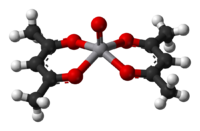Acetylacetone

| |||
| |||
| |||
| Names | |||
|---|---|---|---|
| IUPAC names
(3Z)-4-Hydroxy-3-penten-2-one (enol form)
Pentane-2,4-dione (keto form) | |||
Other names
| |||
| Identifiers | |||
3D model (
JSmol ) |
|||
| 741937 | |||
| ChEBI | |||
| ChEMBL | |||
| ChemSpider | |||
ECHA InfoCard
|
100.004.214 | ||
| EC Number |
| ||
| 2537 | |||
| KEGG | |||
PubChem CID
|
|||
RTECS number
|
| ||
| UNII | |||
| UN number | 2310 | ||
CompTox Dashboard (EPA)
|
|||
| |||
| Properties | |||
| C5H8O2 | |||
| Molar mass | 100.117 g·mol−1 | ||
| Appearance | Colorless liquid | ||
| Density | 0.975 g/mL[1] | ||
| Melting point | −23 °C (−9 °F; 250 K) | ||
| Boiling point | 140 °C (284 °F; 413 K) | ||
| 16 g/(100 mL) | |||
| −54.88·10−6 cm3/mol | |||
| Hazards | |||
| GHS labelling: | |||
   
| |||
| Danger | |||
| H226, H302, H311, H320, H331, H335, H341, H370, H412 | |||
| P201, P202, P210, P233, P240, P241, P242, P243, P260, P261, P264, P270, P271, P273, P280, P281, P301+P312, P302+P352, P303+P361+P353, P304+P340, P305+P351+P338, P307+P311, P308+P313, P311, P312, P321, P322, P330, P337+P313, P361, P363, P370+P378, P403+P233, P403+P235, P405, P501 | |||
| NFPA 704 (fire diamond) | |||
| Flash point | 34 °C (93 °F; 307 K) | ||
| 340 °C (644 °F; 613 K) | |||
Explosive limits
|
2.4–11.6% | ||
Except where otherwise noted, data are given for materials in their standard state (at 25 °C [77 °F], 100 kPa).
| |||
Acetylacetone is an
Properties
Tautomerism
| Solvent | Kketo→enol |
|---|---|
| Gas phase | 11.7 |
| Cyclohexane | 42 |
| Toluene | 10 |
THF |
7.2 |
| CDCl3[3] | 5.7 |
DMSO |
2 |
| Water | 0.23 |

The
The equilibrium constant tends to be high in nonpolar solvents; when Kketo→enol is equal or greater than 1, the enol form is favoured. The keto form becomes more favourable in polar, hydrogen-bonding solvents, such as water.
Acid–base properties
| Solvent | T/°C | pKa[8] |
|---|---|---|
| 40% ethanol/water | 30 | 9.8 |
| 70% dioxane /water |
28 | 12.5 |
| 80% DMSO /water |
25 | 10.16 |
| DMSO | 25 | 13.41 |
Acetylacetone is a
- C5H8O2 ⇌ C5H7O−2 + H+

In the acetylacetonate anion, both
Preparation
Acetylacetone is prepared industrially by the thermal rearrangement of isopropenyl acetate.[10]
Laboratory routes to acetylacetone also begin with acetone. Acetone and acetic anhydride ((CH3C(O))2O) upon the addition of boron trifluoride (BF3) catalyst:[11]
- (CH3C(O))2O + CH3C(O)CH3 → CH3C(O)CH2C(O)CH3
A second synthesis involves the base-catalyzed condensation (e.g., by sodium ethoxide CH3CH2O−Na+) of acetone and ethyl acetate, followed by acidification of the sodium acetylacetonate (e.g., by hydrogen chloride HCl):[11]
- CH3CH2O−Na+ + CH3C(O)OCH2CH3 + CH3C(O)CH3 → Na+[CH3C(O)CHC(O−)CH3] + 2 CH3CH2OH
- Na+[CH3C(O)CHC(O−)CH3] + HCl → CH3C(O)CH2C(O)CH3 + NaCl
Because of the ease of these syntheses, many analogues of acetylacetonates are known. Some examples are
Reactions
Condensations
Acetylacetone is a versatile bifunctional precursor to heterocycles because both keto groups may undergo condensation. For example, condensation with Hydrazine produces pyrazoles while condensation with Urea provides pyrimidines. Condensation with two aryl- or alkylamines gives NacNacs, wherein the oxygen atoms in acetylacetone are replaced by NR (R = aryl, alkyl).
Coordination chemistry

- MBz + z Hacac ⇌ M(acac)z + z BH
Both oxygen atoms bind to the metal to form a six-membered chelate ring. In some cases the
Biodegradation
The enzyme
References
- ^ "05581: Acetylacetone". Sigma-Aldrich.
- ISBN 0471936235.
- .
- PMID 16417375.
- .
- .
- ISBN 3-527-30618-8.
- ^ IUPAC SC-Database Archived 2017-06-19 at the Wayback Machine A comprehensive database of published data on equilibrium constants of metal complexes and ligands
- S2CID 96848983.
- ISBN 9783527306732.
- ^ .
- ^ O'Brien, Brian. "Co(tfa)3 & Co(acac)3 handout" (PDF). Gustavus Adolphus College.
- PMID 12379146.






